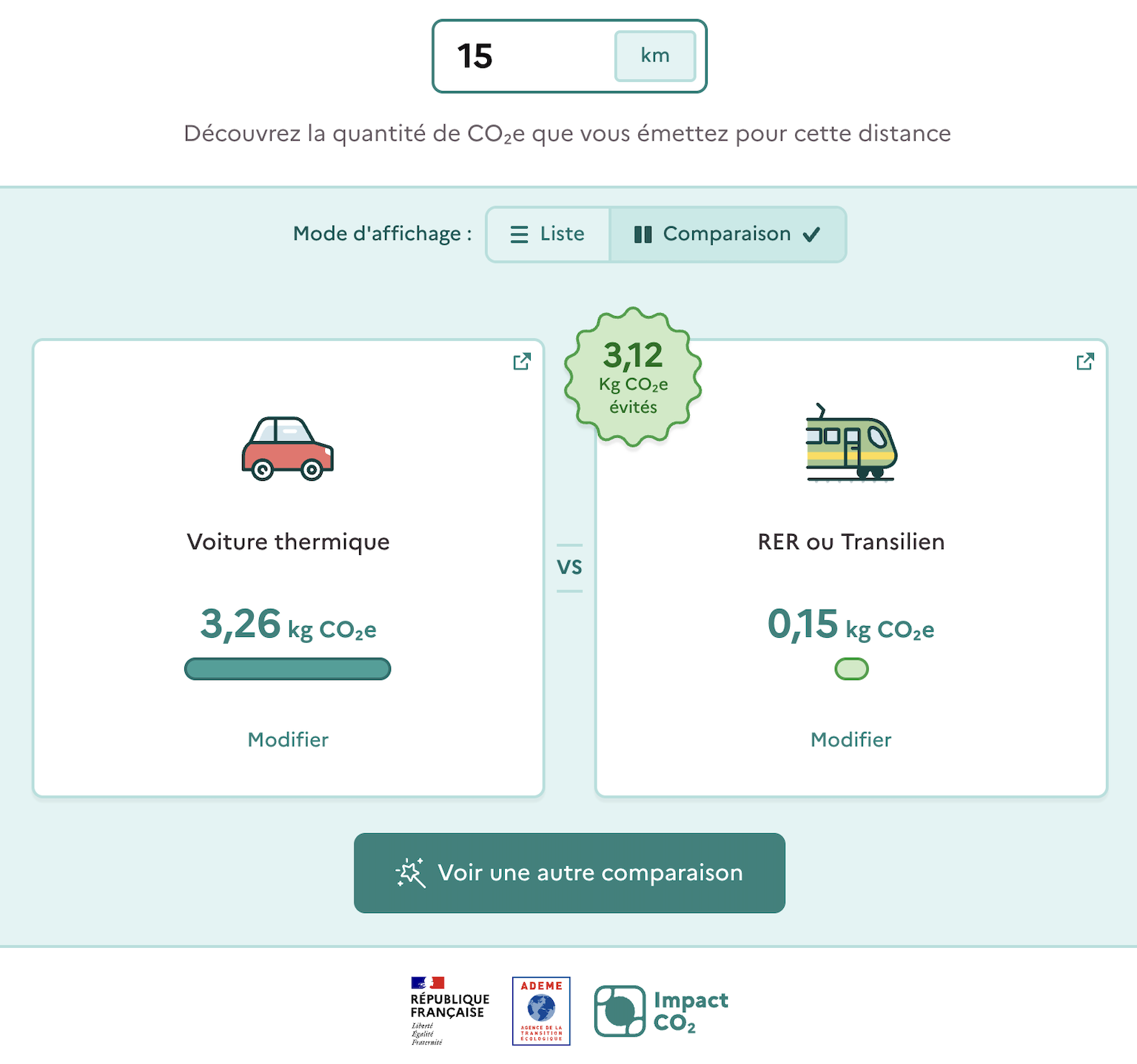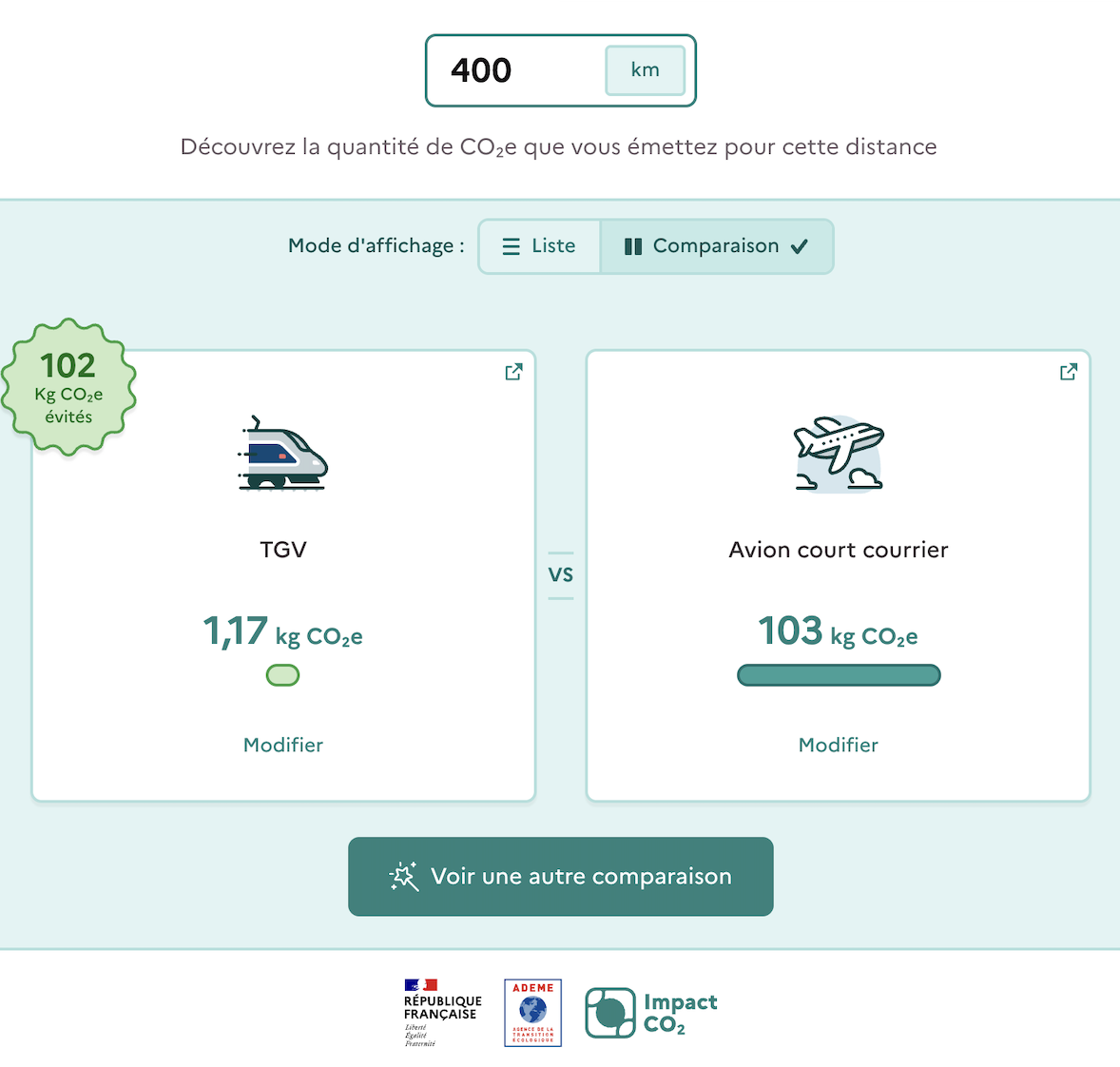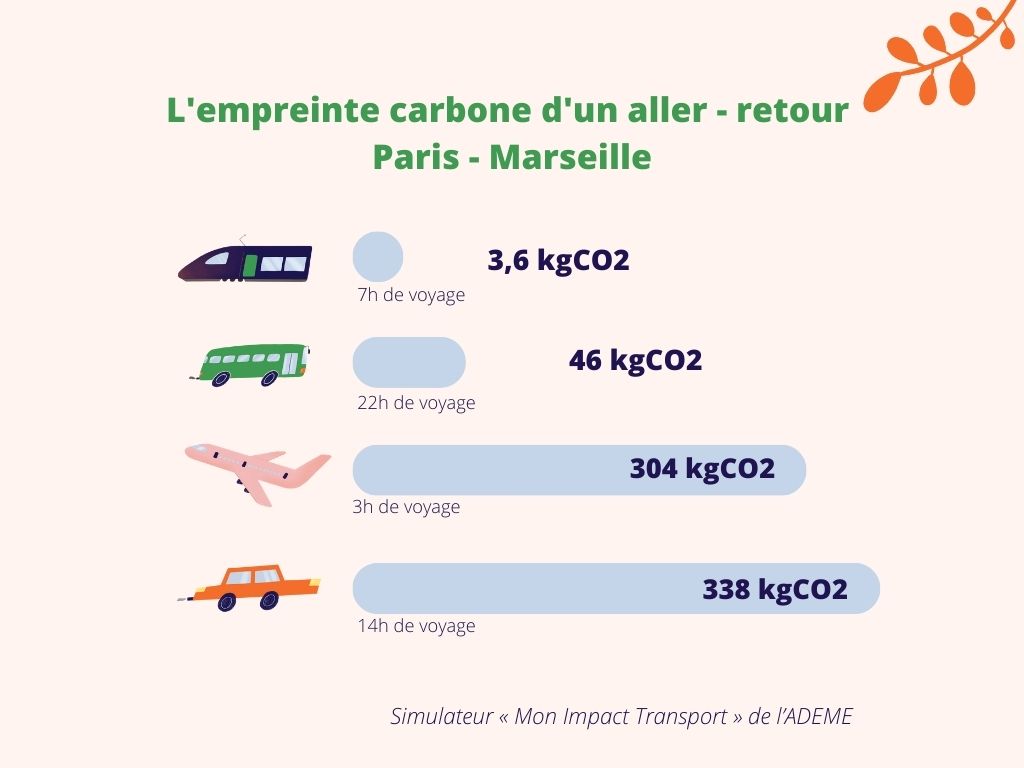Réduire les émissions de CO2e dans le secteur du transport : une nécessité pour les entreprises

L’énergie consommée dans les transports représente un enjeu climatique majeur en France chaque année.
Le secteur du transport est l’un des plus gros émetteurs de GES en France. Il représente près de 30 % des émissions de CO2e à l’échelle nationale, selon l’Ademe. Voitures, poids lourds, avions : chaque kilomètre parcouru a un coût pour le climat et alourdit l’empreinte carbone collective. Le calcul de ces impacts révèle des marges de progrès significatives.
Pour les entreprises, les impacts sont multiples. Qu’il s’agisse de la gestion de flottes de véhicules, du transport de marchandises sur une longue distance, ou des déplacements domicile-travail, la contribution du transport aux bilan carbone est significative. Une illustration frappante : dans le secteur tertiaire, par exemple, on observe souvent une sous-estimation de ces postes, alors qu’ils représentent un levier essentiel pour réduire la quantité CO2e générées.
En parallèle, tous les modes de transport n’ont pas le même impact. Un véhicule thermique émet en moyenne 10 fois plus de CO2e par passager-kilomètre qu’un train. Le secteur routier reste largement dominant, bien devant le ferroviaire ou le fluvial.
Dans ce contexte, et alors que la Stratégie nationale bas carbone impose une trajectoire ambitieuse à l’horizon 2050, il devient indispensable pour les entreprises d’agir : mieux planifier les déplacements, repenser les usages, électrifier les voitures, ou miser sur la logistique bas carbone.
Mais par où commencer ?
Et surtout, quelles actions sont réellement efficaces pour réduire l’impact du transport sur le bilan de gaz à effet de serre (GES) d’une organisation ?
2. Comment réduire les émissions de CO2e dans le transport ?
2.2 Transition énergétique des flottes
2.3 Technologies et innovation
3. Cas d’entreprises et bonnes pratiques
3.1 Des exemples concrets de réduction des émissions dans le transport
3.2 Exemple : logistique optimisée chez un chargeur
3.3 Exemple : transition de flotte dans une entreprise de services
Les enjeux des émissions de CO2e dans le transport
🚗 Transport de personnes : un poids lourd dans les bilans
Le transport de personnes est le premier émetteur de GES en France. Selon un rapport annuel du Haut Conseil pour le Climat, il représente à lui seul 52 % des émissions de CO2e du secteur du transport. La voiture individuelle reste le mode le plus utilisé. Elle est aussi le plus polluant, derrière l’avion.
Selon des données, un passager parcourant 15 kilomètres en voiture thermique émet en moyenne 3,26 kg CO₂e, contre seulement 0,15 kg CO₂e en RER. Sur les trajets domicile-travail ou professionnels, ce choix pèse donc lourd dans l’empreinte carbone des organisations. La distance parcourue influence directement l’impact climatique.

Les entreprises du secteur tertiaire sont directement concernées. Leurs bilan GES montrent souvent une part importante des émissions liées à la mobilité.
La localisation joue aussi un rôle. En Île-de-France, les transports collectifs sont plus développés. Mais dans de nombreuses zones, la voiture reste incontournable. Résultat : les tonnes de CO2e liées aux déplacements explosent.
🚚 Transport de marchandises : un enjeu clé pour les entreprises
Le transport de marchandises est responsable de 42 % des émissions de CO2e du secteur du transport. En France, il repose majoritairement sur le routier. Or, un poids lourd émet en moyenne 903 g de CO2e par tonne-kilomètre. Le calcul de l’émission de gaz à effet de serre (GES) doit intégrer la quantité de marchandises transportée et le nombre de trajet effectués.
Les entreprises qui expédient, reçoivent ou livrent des produits sont donc concernées, qu’elles soient chargeurs, distributeurs ou prestataires logistiques. Pour certaines, comme dans l’e-commerce ou l’industrie, le transport représente une part majeure de leur bilan de gaz à effet de serre (GES).
La pression réglementaire augmente. En Europe, le Green Deal vise la neutralité carbone d’ici 2050. En France, la Stratégie nationale bas carbone impose une réduction drastique des émissions du secteur routier. Les entreprises doivent donc anticiper.
✈️ Transport aérien : un impact disproportionné
Le transport aérien génère un impact CO₂ majeur malgré le fait qu’il ne représente qu’une faible part des déplacements (moins de 2 % des kilomètres parcourus en France). En cause : une intensité carbone par kilomètre très élevée.
Selon les données de l’ADEME, un passager en avion émet environ 103kg de CO₂e, contre 1,17 kg de CO₂e en TGV.

Les vols domestiques et professionnels alourdissent considérablement les bilans GES des entreprises. Un trajet aller-retour Paris-Marseille en avion peut générer jusqu’à 304 kg de CO₂e par personne.

Certaines entreprises intègrent désormais des critères de distance et de durée pour limiter le recours au mode de transport aérien. D’autres favorisent le train pour les trajets en dessous de 4 heures, dans le cadre d’une politique de mobilité bas carbone. Des leviers simples, mais à fort impact sur l’empreinte carbone globale.
Les 7 avantages à réaliser le Bilan GES de son entreprise.
Comment réduire les émissions de CO2e dans le transport ?
🧭 Optimiser les trajets : un premier levier concret
La première action, souvent sous-estimée, est l’optimisation des trajets. Pour les entreprises, cela signifie repenser la manière dont les kilomètres sont parcourus.
Côté transport de marchandises, cela passe par :
-
- le groupage des livraisons,
- la réduction de la distance parcourue à vide,
- l’amélioration du taux de chargement,
- la mutualisation logistique entre chargeurs français.
Chaque amélioration permet d’économiser des tonnes de CO2e, tout en réduisant les coûts.
Côté mobilité des salariés, les leviers sont :
-
- le développement du télétravail,
- la promotion du covoiturage,
- l’accès facilité aux transports en commun,
- la mise en place de plans de mobilité entreprise.
Ces solutions peuvent être intégrées directement dans un bilan GES, afin de mesurer leur efficacité.
⚡ Transition énergétique : électrifier les flottes et diversifier
Changer de motorisation est un levier majeur. En France, les véhicules électriques émettent jusqu’à 22% à 81% de CO2 de moins que les voitures essence et diesel.
Pour les flottes d’entreprises, le passage à l’électrique permet de réduire considérablement les émissions. C’est aussi une façon d’anticiper les futures zones à faibles émissions (ZFE), déjà actives à Paris et dans d’autres grandes villes.
Le secteur routier reste difficile à décarboner. Mais des solutions émergent pour les poids lourds : camions électriques, hydrogène, biogaz. Ces options restent coûteuses mais deviennent de plus en plus accessibles.
🛰️ Technologies et innovation : accélérer la bascule
Les technologies émergentes ouvrent de nouvelles possibilités. Par exemple :
- systèmes de suivi des émissions en temps réel,
- logiciels de planification intelligente des tournées,
- plateformes de mutualisation inter-entreprises,
- outils pour mesurer précisément l’empreinte carbone par flux.
Ces solutions s’intègrent aux bilan carbone et facilitent la prise de décision. Certaines entreprises utilisent déjà ces outils pour affiner leur stratégie bas carbone et piloter leurs émissions à la tonne près.
En France comme en Europe, ces innovations bénéficient de soutiens publics (subventions, crédits d’impôts, appels à projets de l’Ademe). Une opportunité pour toute entreprise souhaitant accélérer.
Comment pérenniser et renforcer son entreprise par une trajectoire bas-carbone réussie.
Cas d’entreprises et bonnes pratiques
🏢 Des exemples concrets de réduction des émissions dans le transport
De nombreuses entreprises ont déjà engagé des actions concrètes pour réduire les émissions de CO2e liées au transport. Les résultats sont mesurables, à condition d’intégrer ces postes dans un bilan carbone précis et complet.
Le retour d’expérience de plusieurs organisations ayant réalisé leur bilan GES avec Global Climate Initiatives montre la diversité des approches. Ces témoignages illustrent des stratégies adaptées à chaque activité.
La FFBad confie à GCI l’évaluation carbone de ses activités, et se poursuit avec la réalisation du bilan GES de 20 clubs affiliés.
Le Groupe Schmidt a pu enrôler 80% de ses fournisseurs (en termes de volume financier), et réaliser une économie de 242 tonnes de CO2.
Natural Grass a été accompagné par les experts carbone de GCI pour la réalisation de son premier bilan des émissions de GES.
-
- La mise en place de flottes de véhicules électriques,
- Le recours accru au rail ou au fluvial pour les marchandises,
- La généralisation du télétravail pour réduire les trajets domicile-travail,
- L’adoption d’un logiciel de gestion pour optimiser les tournées de livraison,
- La sensibilisation interne sur l’impact des déplacements professionnels.
🚛 Exemple : logistique optimisée chez un chargeur
En 2020, PepsiCo France s’est engagée dans la démarche FRET21, portée par l’ADEME et le ministère de la Transition écologique, avec pour objectif de réduire de 16 % ses émissions de CO₂e liées au transport sur trois ans.
Pour atteindre cet objectif, l’entreprise a mis en œuvre plusieurs leviers :
- Optimisation des itinéraires : modification du réseau de sourcing et de distribution pour réduire les distances parcourues, entraînant un gain de 2 300 tonnes de CO₂e.
- Réduction des trajets à vide : développement de solutions de backhauling en partenariat avec les fournisseurs pour améliorer le taux de chargement des camions.
- Renforcement du transport ferroviaire : mise en place de liaisons multimodales rail/route, notamment entre les dépôts de Le Quesnoy et Saint-Alban-les-Eaux, permettant d’éviter 1 100 tonnes de CO₂e.
Ces actions s’inscrivent dans une stratégie globale de décarbonation de la chaîne logistique, démontrant l’impact positif de l’optimisation des flux de transport sur la réduction des émissions de gaz à effet de serre.
🚗 Exemple : transition de flotte dans une entreprise de services
Une société de services basée en région parisienne a remplacé progressivement ses voitures thermiques par des véhicules électriques. Elle a également mis en place un système de suivi des kilomètres parcourus et une plateforme de covoiturage interne.
Cette stratégie a permis de diviser par deux les émissions liées à la mobilité des salariés, tout en améliorant leur confort et en réduisant les coûts de carburant.
💡 Ces actions montrent qu’il est possible de réduire significativement l’empreinte carbone liée au transport, sans sacrifier l’efficacité.
À condition de disposer de données fiables, de suivre les bons indicateurs, et d’aligner la démarche avec les objectifs fixés par la Stratégie nationale bas carbone.
Qu’il s’agisse du transport de marchandises ou de celui des personnes, les solutions existent :
- optimiser les trajets,
- adopter de nouvelles motorisations,
- tirer parti des innovations,
- s’appuyer sur un bilan carbone structuré pour piloter ses décisions.
La démarche concerne tous les types d’organisations :
👉 une entreprise publique doit aligner ses pratiques avec les politiques territoriales,
👉 une très grande entreprise doit intégrer les enjeux de mobilité à l’échelle de sa chaîne logistique,
👉 une association peut agir sur les déplacements de ses membres,
👉 un événement peut anticiper l’impact des transports dès la phase de conception,
👉 une collectivité peut jouer un rôle moteur dans la transition de ses acteurs économiques,
👉 même les services numériques ont une part indirecte liée aux mobilités professionnelles ou à la livraison de matériels.
Quelle que soit la structure, intégrer le transport dans sa stratégie bas carbone est désormais indispensable.
Le défi est de taille. Mais il ouvre aussi la voie à des gains économiques, sociaux, et environnementaux.
Sources
- https://empreinte-baroudeuse.fr/quel-moyen-de-transport-pollue-le-plus/
- émissions GES transport de personnes
- Émissions transport de marchandises
- un poids lourd émet en moyenne 903 g de CO2e par tonne-kilomètre
- les véhicules électriques émettent jusqu’à 22% à 81% de CO2 de moins que les voitures essence et diesel
- Pepsico France
- Renforcement du transport ferroviaire









